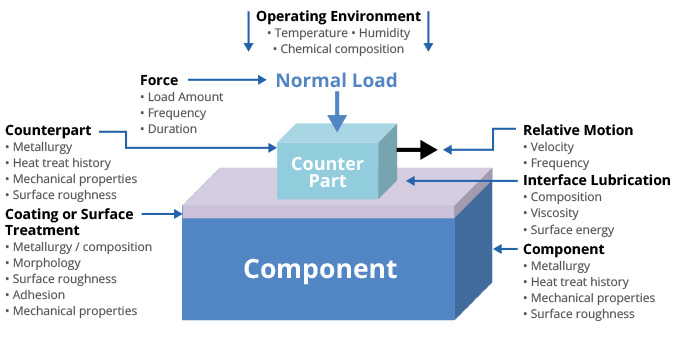Tribology Testing Overview
Tribology – the science and technology of wear and friction between interacting surfaces in relative motion – is critical for understanding performance characteristics and the durability of mechanical components. Friction and wear have detrimental effects on the running behavior and operating characteristics of mechanical systems – components, assemblies and machines. Some of these negatives effects include the following:
- Energy losses
- Heat and noise generation
- Vibrations
- Leaks & debris production
- Surface degradation
- Compromise of component properties
- Erratic friction behavior
- Degradation of parts' exterior
- Seizure leading to system or component failure
The understanding gained from evaluating component specific friction and wear behavior can be utilized to improve component design; select the optimum material for the component; fine tune operating parameters; make appropriate lubrication choices; and select the optimum surface treatment/coating for the component. Optimizing the tribological characteristics of key mechanical components can improve system performance, service life, reliability and maintenance costs.
Tribological System

Tribology testing generates critical information regarding the failure mechanisms of mechanical components, resulting in solutions that improve performance and/or lower costs. This testing can be done under three different sets of conditions:
-
Testing on sample coupons. The test coupons and the counterpart part are made from the same material as the actual component and have similar metallurgical and surface characteristics. These coupons are tested using standard tribology testing equipment such as the Falex Pin & Vee Block test; Block-on-Ring test; Amsler twin-disk test; Taber test etc. The test equipment selection is based upon which equipment most closely simulates the wear and contact mode experienced by the actual component.
-
Component level testing on simulated test rigs. This testing is done on actual components (which may be dimensionally modified to accommodate them in the test rig) which are subjected to the same wear and contact modes that they experience in real life. The test conditions, such as velocity, load, lube and lube contaminants, operating temperature etc., can be varied to study their influence on wear and friction characteristics of the actual component.
-
Component level testing on the actual equipment. These tests are conducted in the actual equipment where the test component operates. The equipment, such as an actual automotive engine, is fully instrumented to measure output parameters such as loads, temperature etc. – that are, in turn, utilized to calculate the relevant performance parameters such as fiction coefficient, wear rate etc. These tests are the closest simulation to actual component performance.